Introduction
Tomato (Solanum lycopersicum L.) is considered one of the most cultivated vegetables in the world (Faostat, 2019), while Brazil is the tenth largest producer of table tomatoes with nearly of 4.1 million tonnes planted in an area of 57.134 thousand hectares (Faostat, 2019). Fertilization is considered one of the most important factors to maximize tomato production, since this vegetable is very demanding in terms of nutrition, mainly by nitrogenated fertilizers can increase the productivity and quality of the fruit (Bastos et al., 2013). Recently, nitrogen (N) fertilizer applications have increased considerably; the optimum N rate range for tomato production is 110 to 150 kg ha-1 (Malavolta, 1981).
Nitrogen fertilization increases the concentration of some volatile compounds, titratable acidity, soluble sugars and soluble solids, however, decreases firmness and vitamin C content in tomato fruits (Bénard et al., 2009; Kuscu et al.,2014), while the application of S increases the concentration of lycopene and overall production (Zelená et al., 2009; Silva et al., 2014). In plants, N is in the form of proteins, and S is a constituent of two essential amino acids, cysteine and methionine. In the case of deficiency of these elements, there will be a decrease in the production of these amino acids and the proteins containing them will not be formed, allowing the plant metabolism to be modified according to the N-form combined with the S in the fertilization (Marschner, 2012). However, both N and S, may present synergism and to some extent influence fruit production, maturation and quality (Marschner, 2012).
Within this context, Silva et al. (2014) verified that the N/S ratio decreases with application of S in the tomato, also noticing that the balance between N and S is important, because higher rates of one nutrient can lead to less availability of the other to the plants, growth, yield and post-harvest quality of the crop. Due to studies scarcity on sulphate fertilization in tomato, the present work aimed to evaluate the interaction between N and S in tomato fruit quality.
Material and methods
The experiment was carried out under greenhouse conditions from July to December 2015 at the Department of Soil Science, Federal University of Lavras, Lavras-MG (latitude 21 ° 14 ‘43 South and longitude 44 ° 59’ 59 West, and altitude of 919 m), in pots containing 5 dm-3 of soil, filled with samples of the 0-20 cm layer of a soil characterized as Anionic Acrudox, according to the Soil Survey Staff (2014). Physicochemical soil properties were: sand = 160 g kg-1; Silt = 150 g kg-1; Clay = 690 g kg-1; pH in water = 5.0; organic matter = 28.7 g kg-1; P (Mehlich-1) = 1.1 mg dm-3; K = 54 mg dm-3; Ca = 1.5 cmolcdm-3; Mg = 0.2 cmolc dm-3; Al = 0.4 cmolc dm-3; H + Al = 6.3 cmolc dm-3; B = 0.3 mg dm-3; Cu = 2.5 mg dm-3; Fe = 28.0 mg dm-3; Zn = 0.4 mg dm-3; S = 11.7 mg dm-3; Mn = 17.5 mg dm-3; CEC at pH 7 = 8.1 cmolc dm-3; Base Saturation = 22%.
The experimental was a completely randomized design with two factors: (1) nitrogen dose factor with five levels (100, 200, 300 and 400 mg dm-3 ), in the form of urea and two sulphur dose factor with three levels: 0, 60 and 120 mg dm-3, in the form of calcium sulphate (agricultural gypsum), with four replicates, for a total of 60 plots.
Based on the soil chemical analysis, liming was carried out to raise the saturation by bases to 80%, using limestone filler (PRNT = 99%). After soil incubation for 30 days, with humidity close to 60% of the total volume of pores (VTP), basic fertilization was carried out with the application of S rates, according to treatments, via soil in a single application, and 1463 mg dm-3 of P, as triple superphosphate, 689.65 mg dm-3 of K as potassium chloride, and Ca at the concentration of 6 g L-1, in the form of calcium chloride. Each vessel received a tomato seedling, Angelim cultivar, from the hybrid saladete group with a determined growth habit. The rates of N were applied in cover, divided in four times at 10, 40, 70, and 100 days after transplantation (DAT), in solution form. Together with the rates of N, 75 mg of K per pot was applied. A solution containing 2 g L-1 of B was applied via the leaf from the beginning of the flowering biweekly in the form of boric acid.
Plants were tutored by means of cuttings with approximately 1.5 m of height and the plants tied with chains. From 20 DAT, weekly sprouting was carried out, for the conduction of a single rod. The Irrigation was performed by drip irrigation and its management was carried out by controlling soil water content. Phytosanitary control was carried out by means of the spraying of acaricides and fungicides when necessary, according to the recommendations of the integrated pest and disease management for the tomato crop.
Fruits were harvested manually and weekly from 120 days after planting, in the breaker stage, characterized by the breaking of the green fruit stage with the appearance of slightly yellowish or reddish patches on the region of the scar. Harvested fruits were packed in plastic bags along the production cycle and packaged in a cold camera.
At the end of the experiment, fruits were assessed for (1) firmness using a manual penetrometer (Mc-Cormik model) at two points equidistant in the equatorial portion of each fruit, obtaining the values in Newton (N) before Freezing; (2) soluble solids content (SS), which was obtained by direct reading in bench refractometer (Optech brand RMT model), using homogenized pulp and filtered at room temperature, obtaining values in °Brix; (3) the titratable acidity (TA) determined by the titration method as described by (IAL, 2005); (4) SS/TA ratio obtained by the ratio between soluble solids and titratable acidity; (5) pH of the pulp with pH meter (brand TECNAL); (6) beta carotene and lycopene content, obtained by spectrophotometric analysis according to the methodology described in Rodriguez-Amaya (2001) and (7) vitamin C content, obtained by the colorimetric method using 2,4-dinitrophenylhydrazine (Strohecker and Henning, 1967), and results were expressed as mg ascorbic acid 100g-1.
Results were submitted to analysis of variance. When the significance was found, the averages were compared by the Tukey test, at 5% probability. The models were adjusted based on the significance of the parameters, in the coefficient determination. Statistical analysis was carried out using the software version R 3.2.3 (R Core Team, 2019).
Results and discussion
The values of firmness (F), titratable acidity (TA), soluble solids (SS), SS/TA ratio, vitamin C, lycopene and p-carotene were influenced (P < 0.05) by interaction of N x S rates. In relation to pH values, these were influenced (P < 0.05) by the isolated rate factors of N and S only.
For firmness, the interaction between the rates of N and S (Figure 1) it was found that rates 0, 60 and 120 mg dm-3 of S were adjusted to the quadratic regression with the maximum points estimated at 13; 10; and 11N, respectively. Possibly the N contributed to greater firmness in the fruits until the optimum level, and then decrease was verified.
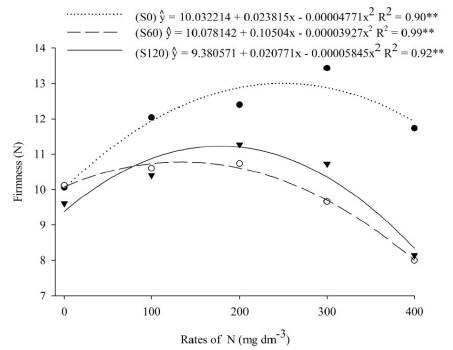
Figure 1 Firmness in the tomato fruits submitted to the rates of N and S. S0: Rates 0 mg dm-3; S60: Rates 60 mg dm-3; S120: Rate 120 mg dm-3. **: Significant at 1% by the 'F' test.
According to Mello et al. (2020), values of firmness found in the study did not present differences. On the other hand, Moreno et al. (2014), while evaluating the increase of rates of N in low level of deficiency and high level of toxicity and how they affect in post-harvest quality in two tomato varieties, observed that above the ideal treatment rate (30 mM) there was a reduction of the firmness of the fruit in the order of 25 to 31.9% for both varieties, as a consequence of the high level of toxicity, corresponding to what was verified in this study.
Soluble solids confer fruit flavour as a function of sugar content, however, variations in this content are expected to depend on the genotype and several factors that influence the ability to import the assimilated photosynthetic by the fruit. Therefore, the uses of cultivars in which the existence of this characteristic can be guaranteed are of fundamental importance in order to allow greater acceptability by the consumer.
The soluble solids content showed an increasing linear adjustment for the 0 mg dm-3 rate of S, varying the Brix value from 3.5 to 4.2, and the 60 mg dm-3 S rate adjusted to the quadratic regression, with the minimum point of Brix estimated at 3.6 as a function of the rates of N (Figure 2). However, the rate of 120 mg dm-3 had no polynomial adjustment, but its overall mean of Brix was 3.9. The soluble solids are the main component responsible for the fruit flavour, being influenced by the fertilization, temperature, irrigation and the genetic trait of the cultivar, which may have contributed to reach this average. The values match with those observed by Monteiro et al. (2008) when evaluating the nutritional level in Italian tomatoes used in industrial processing, but are opposed to those observed by Marouelli et al. (2014) and Bérnard et al. (2009) who obtained a mean value of °Brix of 4.6 as a function of the reduction of N rates.
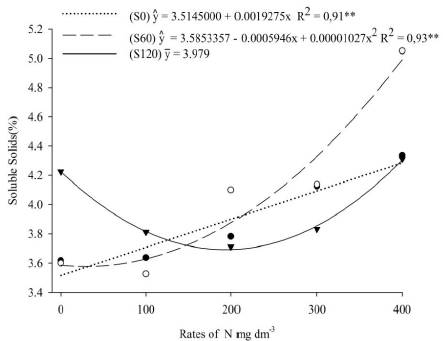
Figure 2 Soluble solids in the tomato fruits submitted to the rates of N and S. S0: Rates 0 mg dm-3; S60: Rates 60 mg dm-3; S120: Rate 120 mg dm-3. **: Significant at 1% by the F test.
The titratable acidity in the tomato fruit presented a quadratic adjustment decreasing for rates 0 and 120 mg dm-3 of S, reaching a mínimum of 0.26 and 0.25%, corresponding to rates 203 and 168 mg dm-3 of N (Figure 3A). Regarding the rate 60 mg dm-3 of S had a linear adjustment as a function of increasing rates of N, reaching a maximum value of TA in the range of 0.32% corresponding to the rate of400 mg dm-3 of N. Values found in this study are considered low compared to the values reported by Tigist et al. (2013) and Mello et al. (2020). But, similar results to the present study were observed by Bérnard et al. (2009) and Kuscu et al. (2014) where they found a significant increase in the titratable acidity as a function of the applied N rates.
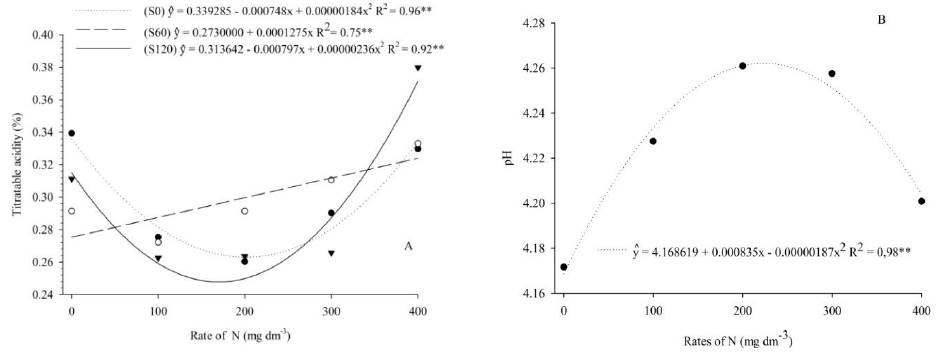
Figure 3 Titratable acidity (A) and pH (B) in the tomato fruits submitted to the rates of N and S. S0: Rates 0 mg dm-3; S60: Rates 60 mg dm-3; S120: Rate 120 mg dm-3. **: Significant at 1% by the ‘F’ test
The pH value in the tomato pulp increased in a quadratic manner with due to the increase of the rates of N up to the estimated rate of 223 mg dm-3 of N, corresponding to the maximum value of 4.26 (Figure 3B), while the rates of S did not statistically differ, presenting a general average of 4. According to Monteiro et al. (2008) pH values below 4, a range considered acidic for tomatoes, is important, because it avoids the proliferation of microorganisms and reduces the period of sterilization of the raw material. For Porto et al. (2013), pH values obtained in the present study may be associated with the higher accumulation of mineral solutes in the pulp of tomato fruits, which caused the consumption of organic acids in the assimilation of N, due to the presence of NH4+.
The pH and titratable acidity (TA) are two important quality attributes of processing tomatoes. Nevertheless, tomatoes typically have sufficient acidity to maintain a pH below 4.6 and, accordingly, are not classified as a low acid food. Because of this tomatoes do not require the more drastic thermal treatments required of foods classified as low acid for the destruction of spoilage microorganisms, to ensure food safety.
The SS/TA ratio in the tomato fruit pulp (Figure 4) shows that for the rates 0 and 120 mg dm-3 of S the data were adjusted to an increasing quadratic regression with the maximum point estimated at 246 and 157 mg dm-3, respectively, corresponding to a SS/TA ratio of 14.6 and 14.8 respectively. The rate of 60 mg dm-3 of S presented a SS/TA ratio of the order of 14.7. The values of the SS/TA ratio obtained in the present study are considered good, since they are above 10, according to what was stipulated by Kader et al. (1978). Schwarz et al. (2013) found values similar to those mentioned above, which allowed inferring that this relationship can be influenced by TA, since the reduction of these values, allowed the increase of this relation, as a function of the rates of N.
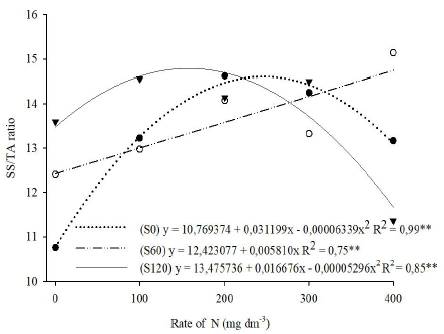
Figure 4 SS/TA in the tomato fruits submitted to the rates of N and S. S0: Rates 0 mg dm-3; S60: Rates 60 mg dm-3; S120: Rate 120 mg dm-3. **: Significant at 1% by the 'F' test.
Vitamin C levels did not adjust to polynomial regression at rates of 0 and 120 mg dm-3 of S, thus presenting an overall mean of 42 and 37 mg 100g-1 of ascorbic acid, respectively, as a function of increasing rates of N (Figure 5). In relation to the rate of 60 mg dm-3 of S in this treatment, quadratic behavior was obtained as a function of N rates, with a maximum increase of 48 mg 100g-1 of ascorbic acid at the rate of 84 mg dm-3 of N, decreasing later. It may have been influenced by the N, since it interferes in the availability of its components, having a positive effect on vitamin C and some phenolic compounds in low applications, besides interfering in the availability of minerals. These results are in agreement with Bérnard et al. (2009) who observed a decrease in the vitamin C content due to an increase in the supply of N. Souza et al. (2010) evaluating the application of wastewater from pigs after filtration in the tomato, obtained vitamin C content ranging from 15 and 22 mg 100g-1. The vitamin C content found in this study was higher than the reported by Tigist et al. (2013).
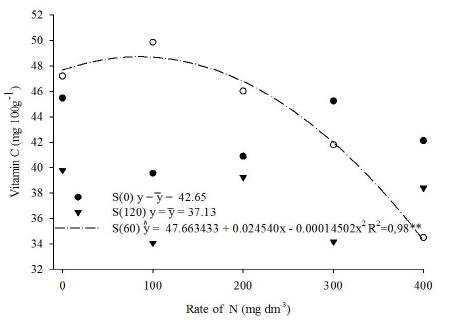
Figure 5 Vitamin C in the tomato fruits submitted to the rates of N and S. S0: Rates 0 mg dm-3; S60: Rates 60 mg dm-3; S120: Rate 120 mg dm-3. **: Significant at 1% by the 'F' test.
Tomato fruits presented a concentration of lycopene at rates 0 and 60 mg dm-3 of S that had no polynomial adjustment, presenting the general average of 37 and 42 pg g-1, respectively (Figure 6A). At the rate of 120 mg dm-3 of S was adjusted to the decreasing quadratic regression with the minimum point estimated at 32 pg g-1, corresponding to the rate of 181 mg dm-3 of N. These results are in agreement with those verified by Kuscu et al. (2014) where observed a decrease in the concentration of lycopene as a function of the supply of N.

Figure 6 Lycopene (A) and β-carotene (B) in the tomato fruits submitted to the rates of N and S. S0: Rates 0 mg dm-3; S60: Rates 60 mg dm-3; S120: Rate 120 mg dm-3. **: Significant at 1% by the ‘F’ test.
According Langi et al. (2018), lycopene predominates 60 - 74% of the carotenoids and is responsible for the red color. The concentration of lycopene in tomatoes is related to the better visual perception of the products, due to the attribute of quality that directly affects their commercial acceptance, besides possessing antioxidant properties.
The interaction of N and S rates showed a concentration of P-carotene at rates 0 and 60 mg dm-3 of S, which had no polynomial adjustment, with a mean of 32 and 41 pg g-1, respectively (Figure 6B). On the other hand, the rate of 120 mg dm-3 of S was adjusted to the decreasing quadratic regression with the minimum point estimated at 32 pg g-1, corresponding to the rate of 181 mg dm-3 of N. It was observed both lycopene concentrations for the P-carotene concentration, the rates of 0 and 60 mg dm-3 did not influence the analysed variables, in contrast with a rate of 120 mg dm-3, which, due to the increasing rates of N, presented a reduction of 79% in the beta- carotene concentration.
Conclusión
The interaction between N and S rates influenced fruit firmness, soluble solids, titratable acidity and SS/TA ratio positively, but negatively for vitamin C, lycopene and p-carotene, although it did not alter fruit quality characteristics of the tomato in relation to the recommended values. The pH was only influenced by increasing rates of N, reaching a maximum of 4.2 that resulted in fruits with a recommended acidity level.
Nevertheless, should be considered in future researches with N and S as a factor to understand new experiences in tomatoes grow and post- harvest, as a fact that this research was only conducted in greenhouse.














